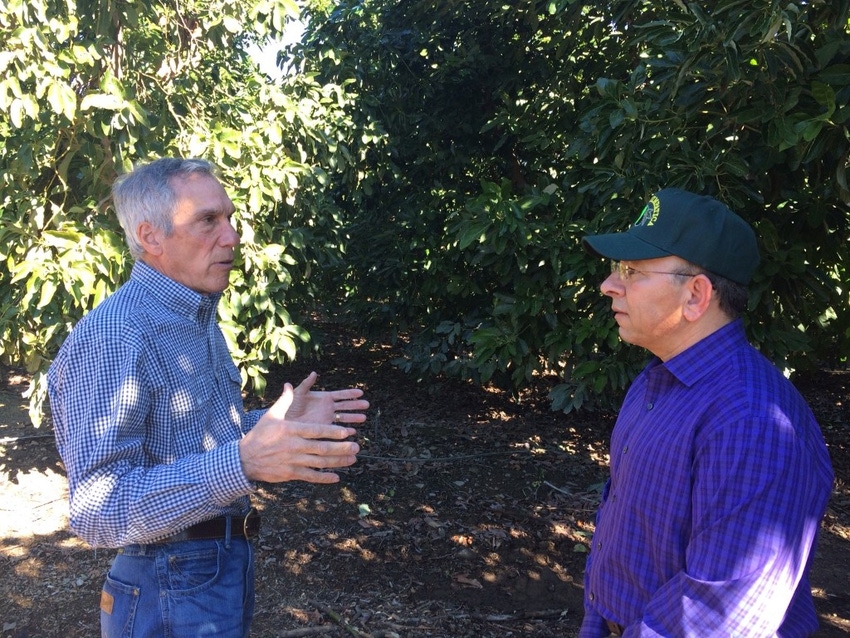
Like family farms across the U.S., most California avocado operations are grower owned with deep family farm lineages wanting to extend their farming legacy. The largest concern for avocado growers is water availability, cost, and quality.Many California avocado groves are in the southern reaches - at the end of the water distribution pipeline where salinity is a concern.
May 12, 2016

Like many family farms across the U.S., most California avocado operations are grower owned with deep family farm lineages with fervent aspirations to extend their farming legacy.
“We have roughly 4,000 growers farming about 48,000 acres with most of the acreage along southern California coastal counties, as far north as Monterey, all the way down to San Diego County,” says Tom Bellamore, president of the California Avocado Commission (CAC).
Bellamore has worked with the CAC and the avocado industry for more than 22 years.
While some California avocado operations are larger, the average farm size is 10 acres. Most of the trees have yielded fruit for decades. While family operations dominate the industry, he is always encouraged when young farmers take stake and establish groves.
“We’ve also had some interest of late from large-scale companies who are looking to invest money in agriculture. I’ll be honest though – it’s a difficult business to start from scratch, but new growers will help sustain our industry moving forward,” Bellamore says.
Nurturing young two-foot tall avocado seedlings into productive fruit-bearing trees takes three years, and he says requires more care than many other fruit trees.
Water challenges
The biggest ongoing concern for avocado growers is the same shared by most farmers in the Golden State - water availability. Being located at the southern tip of California unfortunately places the majority of avocado groves at the end of the water distribution pipeline.
In addition to receiving some water from the State Water Project (SWP) in Northern California, avocado growers rely on water from the Colorado River.
“Due to high salinity levels, water from the Colorado can be rough on avocado trees,” Bellamore explained. “If growers can blend it with water from the annual snowpack (SWR water), ‘salt burn’ is much less a risk.”
Avocado growers also have to deal with expensive water. Growers hope the state lives up to its current forecast of delivering more water this crop year compared to the last two years.
Pest-disease threats
Avocado growers are dealing with a pest-disease complex found in 2012 – the polyphagous shot hole borer. This minute beetle - smaller than a sesame seed - bores tiny holes in avocado trees. The tree is subsequently infected with a fungus which shuts off the tree’s ability to distribute water and nutrients.
“It’s a symbiotic relationship between the hole borer and the fungus that has spelled nothing but trouble for our growers,” Bellamore said. “We’ve invested funds toward research to understand the pest’s biology, and its affinity for avocado trees and other landscape trees found across California.”
Researchers want to determine why the shot hole borer has a preference for one food source over another. Regardless of the reason, once these very prolific pests bore their holes they introduce the fungus to feed their offspring.
The sheer number of holes created in the tree can cause the tree to die. A Section 18 emergency exemption was recently granted for the insecticide Hero to help control the pest.
“I believe it (Hero) will be just one of several tools we’ll need to combat this complex,” said Bellamore.
Labor, food safety
Avocado operations are also dealing with escalating labor costs and mounting regulatory and/or compliance issues. In April, California became the first state in the nation to approve a statewide $15 minimum wage that will be incrementally implemented by 2022.
On food safety, the CAC recognizes the recordkeeping challenges ahead for grove owners tied to the implementation of the Food Safety Modernization Act signed into law four years ago. The Commission has held workshops and created manuals to help owners improve recordkeeping to stay ahead of regulatory hurdles.
Crop competition
Mexico is the world’s largest producer and exporter of avocados, including about 1.6 million metric tons of production for the 2015-2016 marketing year. Peru began growing avocados several years ago and has quickly expanded production.
Bellamore says a major strength for California avocado growers is their proximity to markets.
“We concentrate our sales mostly in the West - California, Arizona, Nevada, and into the Pacific Northwest. We can get our avocados to these markets quickly and guarantee freshness. This is a big advantage over imports,” said Bellamore.
Latest news in western agriculture – Western Farm Press Daily e-news blast - delivered free to your inbox.
Future fruit demand
Multiple organizations have aligned efforts to increase the demand for avocados around the globe. The Hass Avocado Board - the promotion, research, and information arm for Hass Avocado domestic market and consumer development - is funded by a mandatory assessment on U.S. growers and importers.
The World Avocado Organization (WAO), a recently formed, voluntary, and self-funded coalition of avocado-producing countries, is targeting the European Union, Asia, and other non-U.S. markets. Both are coordinated, funded, and share the goal - increasing the demand for avocados.
You May Also Like



